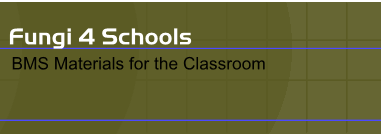A workshop, training exercise or demonstration for GCSE pupils
|
|
Key Stages for Fungi - an integrated collection of teaching resources © British Mycological Society 2005 | ||||||
|
|
|
|
|
| Evaluation comments
I enjoyed the session very much, both as a demonstrator and as a participant. I felt that the ... sessions ... encouraged the students’ learning via different methods - from teaching to stealth science. Bringing the shopping bag full of fungi was particularly good as it encouraged the students to look at fungi as something that we come across every day [postgraduate helper in Life Sciences]. At the start of the sessions the pupils were asked to complete a quick questionnaire regarding fungi. After much deliberation and ‘colluding’ it transpired that most knew none – or very few of the answers. However, after an extremely enjoyable two hours for everyone (including myself) all of the pupils could answer most, if not all, of the questions ... Overall - an extremely interesting and enjoyable experience [helper - 2nd year undergraduate in Honours Biology]. Many many thanks again for your excellent sessions last week – I really enjoyed the Friday one and felt the pupils did as well. It was really good to see them really engaged throughout the full 2 hours – and having such a wide range of stimulating and entertaining activities to do. Spot on! [Widening Participation Officer - Faculty of Engineering & Physical Sciences]. The Funky Fungi sessions were a very enjoyable experience, both for me as a demonstrator and for the pupils involved. It was great to see children getting excited about science - even if that just involved tasting ‘disgusting’ mushrooms and cheeses! The hands-on work was a fun way for the pupils to learn about a field of science new to them and the adaptability of the sessions meant that it was easy to keep them interested in the materials ... [helper - 3rd year undergraduate in Honours Zoology]. Firstly, I would just like to say how much I enjoyed the two sessions. From a personal point of view, they were really productive and I learnt a lot from them with regards to the methods of teaching. I thought that the session was extremely well designed and the students really did seem not just to enjoy it but to actually learn something ... [helper - 3rd year undergraduate in Honours Microbiology]. Acknowledgements
The British Mycological Society, BBSRC and Research Councils UK are thanked for their sponsorship of the events on which the material on this page is based. Thanks are also due for the contributions made by undergraduate project students in 2005 and 2006 (Nicole Benjamin, Kelly Fryer, Jennifer A. Heath, Kate Maull, Charlotte Quinn, Stephanie Roberts, Rohanne Thompson, and Ruth Townley) and postgraduate helpers Julie Huxley-Jones, Mike Littlefair and Tom Westgate. Sincere thanks, also, to Liz Moore, Liz Holden, Margaret Whalley, Louise Sutherland, Vicky Caldwell, Barbara Grundy and Karen Bolshaw for their help in devising, delivering and describing the teaching resources.
National Science Week 2005 sponsored by:
|
|
|||||||||||||||||||||||||||||||||||||||||||||||
Essential Resources |
|
| Opening quiz | CLICK HERE to download PDF |
| What's your favourite fungus? Recommended collection of small group research stories | CLICK HERE to download PDF |
| What are fungi? PowerPoint presentation. We suggest you SAVE the PPT file to your disk rather than opening in your browser | CLICK HERE to download PPT file |
| Supermarket Challenge poster (large file) | CLICK HERE to download PDF |
| Supermarket Challenge explanatory text |
CLICK HERE
to download PDF CLICK HERE to download Word.DOC |
| Thank Fungus for That! poster | CLICK HERE to download PDF |
| Thank Fungus for That! explanatory text |
CLICK HERE to download PDF CLICK HERE to download Word.DOC |
| Mushroom Structure activity class-sheet | CLICK HERE to download PDF |
| Mushroom Structure teacher's guide | CLICK HERE to download PDF |
| Favourite Fungus card game | CLICK HERE to visit the Key Stages for Fungi section to view the card game templates |
| Final quiz | CLICK HERE to download PDF |
| Administrative Resources | |
| Presenter's guide | CLICK HERE to download PDF |
| Risk assessment | CLICK HERE to download PDF |
| Additional Resources | |
| Name Game activity | CLICK HERE to download PDF |
| A Day in Your Life PowerPoint presentation. This is an alternative, cartoon-based presentation. We suggest you SAVE the PPT file to your disk rather than opening in your browser | CLICK HERE to download PPT file |
| A Day in Your Life; a set of teacher's notes relating to the PowerPoint presentation. | CLICK HERE to download PDF |
| Wordsearches - a compendium of six different games | CLICK HERE to download PDF |
| Solutions to wordsearches - a compendium of six solutions | CLICK HERE to download PDF |
Other materials
Demonstration materials can be bought from supermarkets using the items illustrated in the Supermarket Challenge (FF25) poster as your shopping list. It is often easy to obtain a range of cultivated mushrooms (button and closed cup mushrooms to compare with open flats or ‘Portabellos’, chestnuts to compare with whites). Most supermarkets can usually illustrate biodiversity even further with oyster and shiitake mushrooms, and there is increasing availability of so-called ‘exotic’ mushrooms, so it is usually possible to provide the class with five or six different edible mushrooms. Don’t ignore dried mushrooms; again most supermarkets stock dried porcini, wild forest mushrooms, cloud ears, and often several more. All can contribute to discussion of fungal biodiversity.
A good supply of cheeses are well received by pupils (particularly if they are given the opportunity to sample them) and a selection of blue cheeses, brie and camembert can enliven the demonstration and contribute to discussion of the involvement of fungi in production of a major food resource. The explanatory descriptions that accompany the Supermarket Challenge poster include a number of anecdotes about the importance of fungi in developing the flavour of chocolate, in making fizzy drinks, soy sauce, Marmite, Quorn products alongside the obvious bread and alcoholic beverages. All of these can be used to make very interesting points that are relevant to the pupils.
Dissection of the mushrooms can be done quite successfully with disposable picnic ware (plastic knives and forks, paper plates and napkins) from the supermarket. And don’t forget a supply of refuse sacks for the clean-up.
Helpers
It’s also useful to have enough helpers for one helper to ‘adopt’ each table and act a guide or provocateur as appropriate. Helpers can be recruited from amongst older pupils, so that helping in the sessions contributes to the helpers’ own education. In the university/college environment we use undergraduate and postgraduate helpers, many of whom are engaged on educational projects to which the workshop experience contributes. It is very satisfying to observe undergraduate student abilities develop towards accomplished and polished performances as teachers in the Science Week sessions in mid-March.
Flexibility
The programme described above is that developed for a two-hour session but it can be adapted to suit a variety of circumstances and timetable slots. Indeed, there is such a range of resources available on the fungi4schools website that it is possible to modify the materials and content to suit a variety of curricula purposes. We would also emphasise the value of maintaining flexibility in each session, modifying each to satisfy their audiences. In addition, in the university context, it is worth mentioning the unqualified success of incorporating the sessions into undergraduate project assignments is greatly encouraging and amplifies the educational value of the project by expanding its coverage from school year 7 through to undergraduate year 3.
Copy freely for the classroom
| National Science Week sessions sponsored by: | |
 |
|

© British Mycological Society 2006
This webpage © David Moore 2016
Updated December 2016
Close the window to return to the Home Page
The sequence of activities
Welcome: always important and allows mention/emphasis on the underlying agenda which, in our case, is to cultivate interest in science - any science!
Quiz: we normally start with a paper quiz aimed at establishing initial understanding.
Favourite Fungus Stories: each table is issued with a different one-page account of what is hopefully an interesting and relevant Favourite Fungus Story. The language of these is deliberately aimed to be just slightly more demanding than GCSE level (to present a gentle challenge) so younger pupils may need more direction, either clear questions to answer from the text or a more journalistic style of text. The documentation can be downloaded from the 'Favourite Fungi section' of this website as word-processor files the user can modify easily. Each table-group is asked to extract ‘key points’ from their story and then nominate a spokesperson to tell the rest of the group the important features of their story. Each table gets a small prize for successfully completing the task. Sheets coded FF02, FF03, FF04, FF07, FF09, FF10, FF12, and FF13 are usually used (because theses themes reappear on the playing cards). This activity consequently flows from small group research towards a plenary.
PowerPoint presentation: 8 informative slides entitled What are Fungi? to draw all the threads together. This can be usefully illustrated using the material in the Supermarket Challenge (FF25) and Thank Fungus for That (FF26) posters using products bought in from local supermarkets with the posters as take-away leaflets. It is necessary to have a presentation/mini-lecture but it must be kept brief to avoid audience boredom (real or imagined). Having the food products to ‘show and tell’ can help and an alternative approach is to give the pupils boxes of food labels and get them to sort them into groups that do or do not depend on fungi for their manufacture. Also, you might like to try the alternative, cartoon-based presentation offered in the adjoining table.
‘Mushroom Chop-up’ activity: pupils are provided with shop-bought mushrooms plus picnic cutlery and paper plates and asked to dissect the mushrooms. This aims to get pupils to look at mushrooms as organisms, and is an opportunity to discuss biodiversity as well as tissues and structure, structure and function, development (compare button mushrooms with open flats) [CLICK HERE for articles about this topic]. Biodiversity can usually be illustrated with a range of cultivated mushrooms (Oysters and Shiitake almost always available in supermarkets) together with field guides, photographs, models and/or field specimens, depending on season and local circumstances.
Favourite Fungus card game: (FF18 to FF24) is the the final activity. There are 8 suits of cards in the pack, each suit tells one fungus story, and each card gives one of 6 different facts about the fungus story concerned. The cards are shuffled and 5 dealt to each of 4/5 players. Surplus cards are placed face down in the centre. Object of the game is to collect five facts relating to one story (as a variant of the game Rummy). As soon as a player has collected all five cards in a story (which may include one of the jokers), he or she wins by declaring “My Favourite Fungus!” and putting their cards on the table for all to see. The game has been enjoyed by all ages, and we’ve found that most groups, given the time, use the cards for other games like Snap.
Flexibility is important: activities can be used in different orders and for different times according to audience reactions and local circumstances. As described, the activities are usually more than enough for a two-hour session. Reserve supplementary activities are a Name Game (FF17), which can be a good starter activity, as it requires pupil input, and a selection of word searches.
Final quiz: The event ends with a repeat of the quiz used at the start – the same scientific questions are posed but we generally add a few session evaluation questions. We have always asked the pupils to complete written quizzes at the beginning and end of the sessions to provide evaluations for later analysis. Where this is not a consideration, the final quiz could be made interactive by having the pupils use traffic light cards: green cards for yes, red for no and amber for unsure – to get instant and more lively feedback from the students.
National Science Week 2006 sponsored by:




